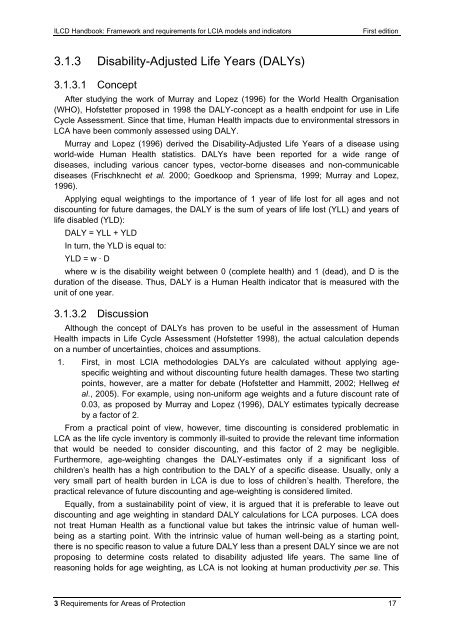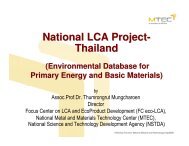ILCD Handbook: Framework and requirements for LCIA models and ...
ILCD Handbook: Framework and requirements for LCIA models and ...
ILCD Handbook: Framework and requirements for LCIA models and ...
Create successful ePaper yourself
Turn your PDF publications into a flip-book with our unique Google optimized e-Paper software.
<strong>ILCD</strong> <strong>H<strong>and</strong>book</strong>: <strong>Framework</strong> <strong>and</strong> <strong>requirements</strong> <strong>for</strong> <strong>LCIA</strong> <strong>models</strong> <strong>and</strong> indicators First edition<br />
3.1.3 Disability-Adjusted Life Years (DALYs)<br />
3.1.3.1 Concept<br />
After studying the work of Murray <strong>and</strong> Lopez (1996) <strong>for</strong> the World Health Organisation<br />
(WHO), Hofstetter proposed in 1998 the DALY-concept as a health endpoint <strong>for</strong> use in Life<br />
Cycle Assessment. Since that time, Human Health impacts due to environmental stressors in<br />
LCA have been commonly assessed using DALY.<br />
Murray <strong>and</strong> Lopez (1996) derived the Disability-Adjusted Life Years of a disease using<br />
world-wide Human Health statistics. DALYs have been reported <strong>for</strong> a wide range of<br />
diseases, including various cancer types, vector-borne diseases <strong>and</strong> non-communicable<br />
diseases (Frischknecht et al. 2000; Goedkoop <strong>and</strong> Spriensma, 1999; Murray <strong>and</strong> Lopez,<br />
1996).<br />
Applying equal weightings to the importance of 1 year of life lost <strong>for</strong> all ages <strong>and</strong> not<br />
discounting <strong>for</strong> future damages, the DALY is the sum of years of life lost (YLL) <strong>and</strong> years of<br />
life disabled (YLD):<br />
DALY = YLL + YLD<br />
In turn, the YLD is equal to:<br />
YLD = w · D<br />
where w is the disability weight between 0 (complete health) <strong>and</strong> 1 (dead), <strong>and</strong> D is the<br />
duration of the disease. Thus, DALY is a Human Health indicator that is measured with the<br />
unit of one year.<br />
3.1.3.2 Discussion<br />
Although the concept of DALYs has proven to be useful in the assessment of Human<br />
Health impacts in Life Cycle Assessment (Hofstetter 1998), the actual calculation depends<br />
on a number of uncertainties, choices <strong>and</strong> assumptions.<br />
1. First, in most <strong>LCIA</strong> methodologies DALYs are calculated without applying agespecific<br />
weighting <strong>and</strong> without discounting future health damages. These two starting<br />
points, however, are a matter <strong>for</strong> debate (Hofstetter <strong>and</strong> Hammitt, 2002; Hellweg et<br />
al., 2005). For example, using non-uni<strong>for</strong>m age weights <strong>and</strong> a future discount rate of<br />
0.03, as proposed by Murray <strong>and</strong> Lopez (1996), DALY estimates typically decrease<br />
by a factor of 2.<br />
From a practical point of view, however, time discounting is considered problematic in<br />
LCA as the life cycle inventory is commonly ill-suited to provide the relevant time in<strong>for</strong>mation<br />
that would be needed to consider discounting, <strong>and</strong> this factor of 2 may be negligible.<br />
Furthermore, age-weighting changes the DALY-estimates only if a significant loss of<br />
children‘s health has a high contribution to the DALY of a specific disease. Usually, only a<br />
very small part of health burden in LCA is due to loss of children‘s health. There<strong>for</strong>e, the<br />
practical relevance of future discounting <strong>and</strong> age-weighting is considered limited.<br />
Equally, from a sustainability point of view, it is argued that it is preferable to leave out<br />
discounting <strong>and</strong> age weighting in st<strong>and</strong>ard DALY calculations <strong>for</strong> LCA purposes. LCA does<br />
not treat Human Health as a functional value but takes the intrinsic value of human wellbeing<br />
as a starting point. With the intrinsic value of human well-being as a starting point,<br />
there is no specific reason to value a future DALY less than a present DALY since we are not<br />
proposing to determine costs related to disability adjusted life years. The same line of<br />
reasoning holds <strong>for</strong> age weighting, as LCA is not looking at human productivity per se. This<br />
3 Requirements <strong>for</strong> Areas of Protection 17



